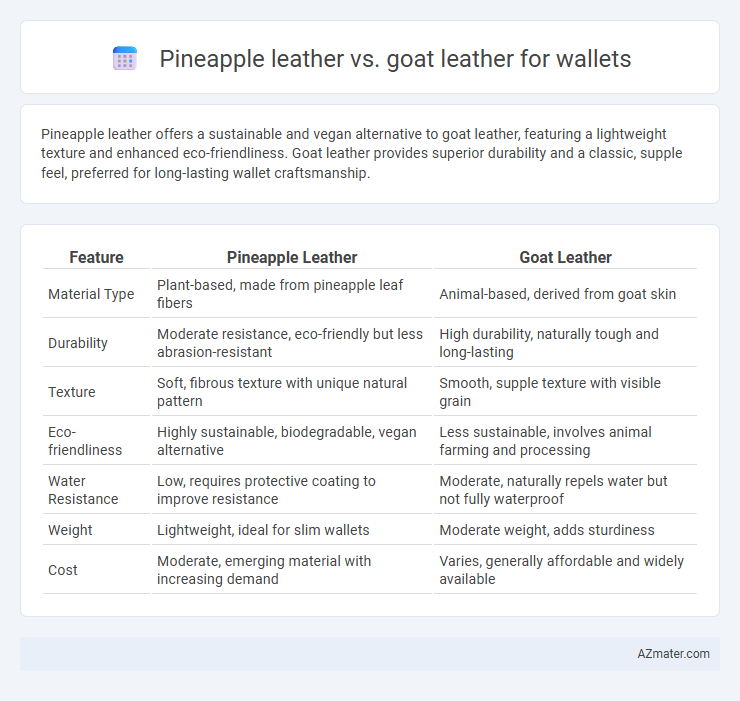Pineapple leather offers a sustainable and vegan alternative to goat leather, featuring a lightweight texture and enhanced eco-friendliness. Goat leather provides superior durability and a classic, supple feel, preferred for long-lasting wallet craftsmanship.
Table of Comparison
| Feature | Pineapple Leather | Goat Leather |
|---|---|---|
| Material Type | Plant-based, made from pineapple leaf fibers | Animal-based, derived from goat skin |
| Durability | Moderate resistance, eco-friendly but less abrasion-resistant | High durability, naturally tough and long-lasting |
| Texture | Soft, fibrous texture with unique natural pattern | Smooth, supple texture with visible grain |
| Eco-friendliness | Highly sustainable, biodegradable, vegan alternative | Less sustainable, involves animal farming and processing |
| Water Resistance | Low, requires protective coating to improve resistance | Moderate, naturally repels water but not fully waterproof |
| Weight | Lightweight, ideal for slim wallets | Moderate weight, adds sturdiness |
| Cost | Moderate, emerging material with increasing demand | Varies, generally affordable and widely available |
Introduction to Pineapple Leather and Goat Leather
Pineapple leather, also known as Pinatex, is an innovative sustainable material made from pineapple leaf fibers, offering an eco-friendly alternative to traditional animal leather. Goat leather, prized for its durability, softness, and natural grain patterns, remains a popular choice for high-quality wallets due to its resilience and luxurious texture. Both materials serve distinct consumer preferences, with pineapple leather appealing to environmentally conscious buyers and goat leather favored by those who prioritize strength and classic leather feel.
Environmental Impact: Pineapple vs Goat Leather
Pineapple leather, also known as Pinatex, offers a sustainable alternative to traditional goat leather by utilizing pineapple leaf fibers, a byproduct of pineapple farming that would otherwise go to waste, significantly reducing agricultural waste. Goat leather production involves livestock farming, which contributes to higher greenhouse gas emissions, land degradation, and water consumption compared to pineapple leather. Choosing pineapple leather for wallets lowers carbon footprint and water usage, promoting eco-friendly fashion with minimal environmental impact.
Production Process Comparison
Pineapple leather, also known as Pinatex, is produced using pineapple leaf fibers that are extracted, processed into a non-woven mesh, and then coated with environmentally friendly polymers to create a durable and sustainable material. Goat leather, on the other hand, undergoes traditional tanning processes involving animal hides, which require chemical treatments such as chrome or vegetable tanning to achieve softness and durability. While pineapple leather offers a renewable, cruelty-free alternative with less water and chemical use, goat leather provides natural texture and strength but involves more resource-intensive and environmentally impactful production methods.
Durability and Longevity
Pineapple leather, made from fibrous leaves of pineapple plants, offers a sustainable alternative to traditional goat leather with moderate durability but less resistance to abrasion and wear over time. Goat leather, known for its natural strength, flexibility, and resilience, typically provides superior longevity and better withstands daily use and environmental factors compared to pineapple leather. For wallets demanding long-term durability and frequent handling, goat leather remains the preferred material while pineapple leather serves well as an eco-friendly option with reasonable lifespan.
Texture and Aesthetic Appeal
Pineapple leather offers a unique, plant-based texture that mimics natural grain patterns with a slightly fibrous, matte finish, appealing to eco-conscious consumers seeking cruelty-free alternatives. Goat leather features a smooth, supple texture with fine grain detail and a natural sheen, providing durability and a classic, luxurious aesthetic. The choice between the two often hinges on preference for sustainable materials versus traditional leather craftsmanship, as pineapple leather presents an innovative look while goat leather delivers timeless elegance.
Comfort and User Experience
Pineapple leather offers a soft, lightweight texture that enhances comfort during extended use, making wallets feel less bulky compared to traditional materials. Goat leather provides a sleek, supple surface with natural breathability, ensuring durability while maintaining a comfortable grip. Users often prefer pineapple leather wallets for vegan-friendly, eco-conscious choices, while goat leather is favored for its classic feel and long-lasting wear.
Price and Market Availability
Pineapple leather, known as Pinatex, is generally more affordable than goat leather due to its sustainable production from agricultural waste, reducing material costs. Goat leather, prized for its durability and premium texture, typically commands higher prices and is widely available in traditional leather markets. Market availability of pineapple leather wallets is expanding steadily in eco-conscious sectors, while goat leather remains dominant and readily accessible in mainstream wallet selections.
Vegan and Ethical Considerations
Pineapple leather, also known as Pinatex, is a sustainable and vegan alternative made from pineapple leaf fibers, offering an eco-friendly solution with minimal environmental impact compared to traditional goat leather. Goat leather, while durable and biodegradable, involves animal farming practices that raise ethical concerns regarding animal welfare and resource consumption. Choosing pineapple leather wallets supports cruelty-free fashion and reduces reliance on animal products, aligning with ethical consumer values and environmental sustainability.
Maintenance and Care Requirements
Pineapple leather requires minimal maintenance, needing only occasional wiping with a damp cloth and avoiding prolonged exposure to water to preserve its texture and color. Goat leather demands more frequent conditioning with specialized leather creams to maintain its suppleness and prevent cracking, especially in dry climates. Both materials benefit from storing wallets in a cool, dry place away from direct sunlight to extend their lifespan.
Conclusion: Which Leather is Better for Wallets?
Pineapple leather, made from sustainable pineapple leaf fibers, offers an eco-friendly, vegan alternative with durability and water resistance suitable for everyday use. Goat leather is prized for its natural softness, flexibility, and long-lasting wear, providing a classic, high-quality feel preferred in traditional wallets. Choosing between pineapple leather and goat leather depends on prioritizing sustainability and innovation versus timeless texture and proven longevity.

Infographic: Pineapple leather vs Goat leather for Wallet
 azmater.com
azmater.com